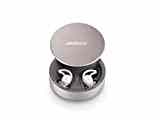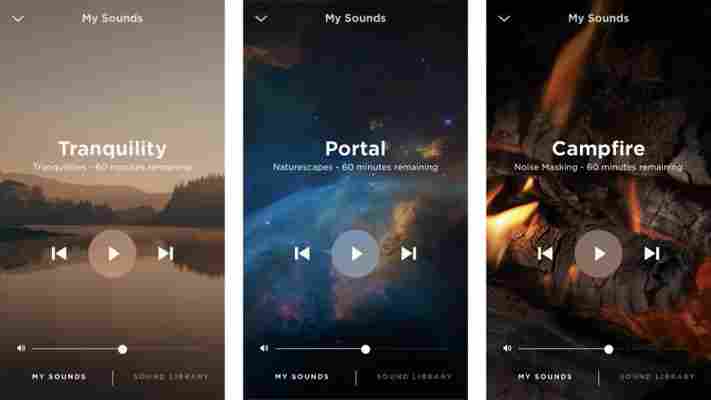Bose’s SleepBuds II have their work cut out to win back consumer confidence, with the original product proving an unwelcome blot on the company’s impressive copybook. They got off to a strong start, selling out on crowdfunding website Indiegogo within six days and raising over £300,000 from almost 3,000 backers. However, after going on general sale in June 2018, it didn’t take long for issues to rear their ugly head.
Although the idea behind them – to help people drift off using relaxing sounds combined with noise-masking technology – drew almost universal acclaim, numerous users reported problems including inconsistent battery life, buds not charging properly, random shutdowns and connectivity issues. Bose eventually discontinued the product in late 2019, offering full refunds to all customers.
That could have been the end of the company’s ambitions for the product but, in September last year, it announced a follow-up was on the way.
The SleepBuds II have undergone a significant overhaul, with Bose addressing the flaws that plagued the original product. I’ve slept with them in my ears for the best part of a month and am pleased to report that I’ve only encountered some minor hiccups during that time.



Bose SleepBuds II review: What do you get for the money?
Bose specialises in premium audio products and the SleepBuds II are no exception. They’ll set you back £230, which gets you the buds, a puck-shaped aluminium charging case, three different sizes of silicone eartips and a USB-C charging cable. The Bose Sleep app – a requirement to use the buds – is available to download for free from both the Apple App Store and Google Play store.
Bose isn’t alone in trying to provide an audio answer to sleepless nights. I reviewed the over-ear Kokoon Relax headphones last year, which are even dearer than the SleepBuds II at a touch over £300 but add the ability to track your sleep patterns using electroencephalogram (EEG) technology. Kokoon is also working on its own in-ear sleep headphones, the NightBuds, which can be preordered here and are set to ship later this year. A more affordable alternative are the Amazfit Zenbuds, currently available for £119 on Amazon.
READ NEXT: Our favourite true wireless earbuds
Bose SleepBuds II review: How do they work?
Like their predecessor, the Bose SleepBuds II are wireless earbuds that connect to your mobile device over Bluetooth. There’s one caveat, though: the SleepBuds II don’t stream audio but instead play sound effect files stored locally on the buds.
It’s a sacrifice made to ensure the buds have long enough battery life to last through the night. Although understandable, this does limit the SleepBuds II’s general appeal. If you’re looking for earbuds that will let you drift off while listening to a podcast or playlist, you should check out our list of the best wireless earbuds instead.
The files you’ll be listening to are all downloaded to the buds via the Bose Sleep app. There are currently 45 to choose from, split into three categories: Noise masking, Naturescapes and Tranquilities.
The 15 noise-masking sounds range from “Warm static” to a crackling “Campfire” and are designed to cover rather than block or cancel out external noises that can potentially disrupt your sleep, such as your partner snoring, foxes shrieking in the garden or traffic from a nearby road.

The 15 Naturescapes comprise sounds from nature designed to help you relax and send you off to sleep. Among these is “Window seat”, which sees you sat next to a windowpane as rain falls outside, lightly landing on the glass and trickling down it. Many find the sound of rain comforting and it was one of the files that helped me to nod off quickest. Other Naturescapes include “Rainforest”, which features a steady deluge accompanied by the tweeting of birds, and “Starboard”, which transports you onto a small motorboat cutting its way through rippling waves.
The final ten sounds – Tranquilities – are slightly more melodic, combining layered tones to create a peaceful headspace. Each is given a suitably relaxing title, such as “Wanderlust” or “Gilded Dream” and I found them great for meditation but not quite as effective at delivering me to the Land of Nod.
Due to the storage limitations of the buds, you’re restricted to the number of files you can have on the Sleep Buds II at any given time. I managed to squeeze in 14 (four Noise masking, five Tranquilities and five Naturescapes) before being told I needed to remove one to make room for another.
The process of transferring sounds to the SleepBuds is very easy. With your buds outside of the case (in your ears is fine), simply enter the Sound Library, select the file you wish to add and proceed with the transfer. On average, it took less than a minute per file.
READ NEXT: The best noise-cancelling headphones
Bose SleepBuds II review: Have battery and connection issues been addressed?
When creating the SleepBuds II, Bose focussed heavily on ironing out the problems that hampered the original.
First and foremost, it replaced the silver-zinc batteries with nickel-metal hydride (NiMH) ones widely-used in hearing aids. The switch has resulted in increased reliability at the cost of shorter battery life – the SleepBuds II offer ten hours of use per charge compared with the original’s 16 hours. That discrepancy is offset by the improved battery life of the charging case, however, which now provides three full charges of the buds, rather than just one.
A third connection prong has been added to the case to ensure the buds connect more easily when rehoused for charging and a magnetic snap indicates they’re positioned correctly. Five small circular LEDs on the rim of the case clearly show the charge level of the case, while two LED strips flash intermittently to show the buds are being charged. It’s all very clear, although you’ll have to check in the app to find out how much battery life the buds themselves have remaining.
During periods of nightly use, I had no battery issues whatsoever. I primarily used them with the Sleep Timer feature set to an hour, meaning the sound playing would cease after that time. After an eight hour sleep, I generally woke to find them with around 60% battery remaining. Once placed back in the case they’d successfully recharge every time, albeit slowly – it takes around six hours for them to fully charge from empty.
They do, however, discharge steadily when not in use so you’ll need to make sure to keep the case topped up regularly if you don’t want them to run flat. After not using them for a few days over Christmas I returned to find them completely empty. According to Bose, this is “normal and expected behaviour” owing to the fact that the case is always active and pinging your buds even when they’re not in use.
It strikes me as a strange design choice to have the case operate that way, but as long as you’re using them regularly you’ll be fine. Bose recommends keeping the case connected to a power supply whenever possible, which isn’t an energy-efficient solution by any means but will mean the buds are ready to use whenever you need them.
The Bluetooth connection, on the other hand, has no such foibles. The buds connected consistently to the app whenever I took them out of the case and not once did I experience them randomly disconnecting or powering down.
Bose SleepBuds II review: What else has changed?
The SleepBuds II are more ergonomic than their predecessor thanks to a flatter, bean-shaped design, which also improves passive noise isolation. The external surfaces have had a makeover, too, and now have a matte, anti-friction coating that eliminates unwanted sounds caused by the buds rubbing against your pillow. The change has certainly achieved its aim. As a side-sleeper who often tosses and turns in the night, I didn’t pick up any hint of the “pillow squeak” suffered by owners of the original SleepBuds.
The app has been redesigned, too, with content divided across the three categories detailed above, and more noise-masking sounds added to better cover a range of nighttime distractions. The existing noise-masking noises have also been retuned, optimising them for the buds’ new, more powerful drivers.
Bose SleepBuds II review: How effective are they?
Although I don’t consider myself a poor sleeper on the whole, I can find it difficult to get to sleep. I also occasionally wake in the middle of the night and struggle to get back to sleep. The SleepBuds II certainly had a positive impact on my ability to drift off, with the Naturescapes most successful in helping me empty my mind. I also found myself waking up before my alarm less frequently and on the occasions I did, I got back to sleep swiftly with the sounds playing.
As I don’t live in a particularly noisy neighbourhood, the noise-masking sounds weren’t quite as useful, but on a couple of occasions where locals insisted on setting off late-night fireworks, I definitely felt their benefit. Even played at low volumes, they did a good job at making me less aware of other sounds in my environment. At higher volumes, I found them less effective but how loud you need the sounds will come down to personal preference. Volume is controlled within the app and finding the right level for you couldn’t be easier.
Tranquilities proved the least effective of the three sound styles for me but they became part of a pre-sleep, meditative routine. They’re great for unwinding after a hectic day and were my go-to when I simply wanted to zone out.
The sleep-aiding properties of the sounds would be redundant if the SleepBuds II were unpleasant to wear for long periods, so it’s fortunate that they’re the most comfortable, unobtrusive buds I’ve ever worn. Their flat profile doesn’t protrude out of your ears at all, so they exert very little pressure on your inner ears while your head is resting against the pillow.
When I fall asleep with standard earbuds on I typically remove them in the middle of the night and, while this did happen the first couple of times I slept with the SleepBuds II in, once I’d become accustomed to wearing them they remained in my ears all night long. It’s worth noting that the SleepBuds II are sweat-resistant, so are safe to use on hot, sticky summer nights.
READ NEXT: The best headphones for every budget
Bose SleepBuds II review: What could be better?
Although the range of sounds on offer is decent, a wider variety wouldn’t go amiss. Bose says it plans to add new sounds and additional content categories in future, which is something to look forward to. It will be interesting to see whether you’ll be able to add your own sounds at some stage, something I expect most users would be keen to do.
Sadly, I imagine it’ll be a while until such slimline buds can incorporate Bluetooth streaming and still have the battery capacity to last all night, but it’s something I’d love to see in the future.
Frustratingly, there’s currently no way to remove files from the buds until their storage is full or check how much storage you have remaining. Trying to add a new file to the buds when they’re at maximum capacity results in a prompt guiding you through the removal process, during which you can take off as many of the files as you want. I fully expect the ability to remove files at your leisure to be added in a future app update.
My other grumbles relate to charging. The case discharging when left unused for a few days is far from ideal and the buds themselves take a whopping six hours to charge from empty. That’s fine if you remember to pop them on charge during the day but, if that slips your mind until after dinner, they’re unlikely to be ready by the time you hit the hay. I got into the routine of putting them on charge every day as soon as I woke up to ensure they’d be good to go that evening.
Bose SleepBuds II review: Should you buy them?
Giving an unequivocal recommendation to any sleep-related product is difficult given how personal everyone’s nighttime routine is. However, based on my experience with the SleepBuds II, I’m happy to give them the thumbs up.
They’re comfortable to the point where it’s easy to forget you're wearing them, using the app is a breeze and the range of sounds on offer had a meaningful effect on both my ability to get to sleep and the quality of the sleep that followed.
The fact you can only listen to sounds created by Bose and the high cost of the buds means they’ll only appeal to people with serious sleep problems, but, for those who do, £230 could be a price worth paying. And with Bose offering a 90-day risk-free trial period, there’s no harm in giving them a go.






Leave a Reply